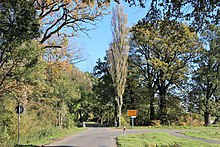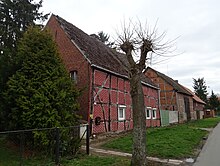Big Beuster
Groß Beuster is a residential area in the Beuster district of the Hanseatic city of Seehausen (Altmark) in the Stendal district in Saxony-Anhalt .
geography
The Groß Beuster residential area, originally a round village, is now the north-western part of the village of Beuster, located below the Elbe, formerly also called Unterbeuster . Groß Beuster is located on an old arm of the Elbe in the north of the Wische in the Altmark . The Elbe dike irrigation, a small ditch, forms the border between Groß and Klein Beuster. The water flows into the Aland west of the village. In 1937 it was still called " Tauber Aland ". In the north lies the Große Wehl , a lake that was created as an "Elbloch" during floods in earlier centuries. The place is in the Middle Elbe Biosphere Reserve . The Aland-Elbe-Niederung nature reserve begins east of the village .
Neighboring towns are Werder in the east, Klein Beuster in the southeast and Esack in the southwest.
history
In 1246 Conradus de Gotberge, Canonicus in Boystere was named as a witness in a document in Wittenberge. Other mentions are 1269 Rodolfus de Boyster , 1300 Ludolphus, decanus in Boiester and 1370 Datum et Actum Boyster . In the Landbuch der Mark Brandenburg of 1375, Omnes prebende collegii in Boester is listed among the margravial church fiefdoms . In 1484 a water mill on Tauben Aland is named. The addition large appears for the first time in documents in 1600 as large = boister , then it is called 1686 large or Nieder Beuster and 1687 large boister . A forge, two tailors, 8 yarn weavers and a wheel maker were listed in a cadastre from 1725 in Groß Beuster .
In 1804 there were three jugs in the village of Groß Beuster , along with many peasant residents, a wheel maker, a boatman, a forge and a windmill.
Incorporations
On September 30, 1928, the rural communities of Groß Beuster and Klein Beuster were merged with the Esack estate to form the rural community of Beuster, and Groß Beuster became part of the municipality of Beuster. When Beuster merged with other municipalities on January 1, 2010 to form a new municipality with the name Hanseatic City Seehausen (Altmark) , Beuster became a district itself. Since then there has only been the Groß Beuster residential area.
Population development
|
|
|
Source if not stated:
religion

The Protestant parish of Groß Beuster was merged with the parish of Klein Beuster on July 27, 1995 to form the parish of Beuster. It is run by the parish area Beuster the church district Stendal in Propst Sprengel Stendal Magdeburg of the Evangelical Church in Central Germany .
The parish of Groß Beuster used to belong to the parish of Groß Beuster in the Altmark . In 1903, the parish looked after: Geestgottberg , Geesterhof, the Bethke'scher Ackerhof and Chausseehaus in the Eickerhöfe estate , Losenrade with Steinfelde , the Elbbrücke and Geestermühle residential areas, and Werder with Werder wood .
The oldest surviving church registers for Groß Beuster date from 1673.
Culture and sights
- The St. Nikolaus Church in Groß Beuster is one of the oldest brick buildings north of the Alps. At the beginning of the 21st century, extensive renovation work took place along with a structural historical investigation and documentation.
- There is a good number of listed half-timbered houses in the village.
Trivia
In earlier times, the rich soil made walking traffic almost impossible in heavy rainy weather. Beckmann wrote in 1753 that the inhabitants of early youth were trained to walk on stilts. The stilts were laced under the feet and were 2 to 3 feet high. They could walk as well as others on foot, he literally writes: without knowing how to approach strok, when others land with their feet on flat surfaces.
literature
- Peter P. Rohrlach: Historical local lexicon for the Altmark (Historical local lexicon for Brandenburg, Part XII) . Berliner Wissenschafts-Verlag, Berlin 2018, ISBN 978-3-8305-2235-5 , pp. 205-208 .
- Wilhelm Zahn : Local history of the Altmark. Edited by Martin Ehlies based on the bequests of the author. 2nd Edition. Verlag Salzwedeler Wochenblatt, Graphische Anstalt, Salzwedel 1928, DNB 578458357 , OCLC 614308966 , p. 174 .
- JAF Hermes, MJ Weigelt: Historical-geographical-statistical-topographical handbook from the administrative districts of Magdeburg . Topographical part. Ed .: Verlag Heinrichshofen. tape 2 , 1842, p. 365 , 12. Groß-Beuster ( digitized version ).
- Johann Marchal, Wilhelm Fascher: Beuster - an Altmarkdorf on the Old Elbe . Chronicle from posthumous records. Ed .: Peter Marchal. Beuster Municipality, Beuster 2007, DNB 984510834 .
Web links
- Groß Beuster in the historical directory of the association for computer genealogy
- Beuster on the website of the Seehausen Association
Individual evidence
- ^ Directory of municipalities and parts of municipalities . Area as of 1 April 2013 (= Statistical Office Saxony-Anhalt [Ed.]: Directories / 003 . No. 2013 ). Halle (Saale) May 2013, p. 117 ( destatis.de [PDF; 1.6 MB ; accessed on August 24, 2019]).
- ↑ a b c d Peter P. Rohrlach: Historical local lexicon for the Altmark (Historical local lexicon for Brandenburg, Part XII) . Berliner Wissenschafts-Verlag, Berlin 2018, ISBN 978-3-8305-2235-5 , pp. 205-208 .
- ^ A b Johann Christoph Becmann, Bernhard Ludwig Beckmann: Historical description of the Chur and Mark Brandenburg . tape 2 . Berlin 1753, Part 5, Book 1, Chapter V, Columns 48-49 ( digitized version ).
- ↑ Saxony-Anhalt viewer of the State Office for Surveying and Geoinformation ( notes )
- ↑ Table sheet 1542: Wittenberge. Reichsamt für Landesaufnahme, 1937, accessed on October 19, 2019 .
- ^ Adolph Friedrich Riedel : Codex diplomaticus Brandenburgensis : Collection of documents, chronicles and other source documents . Main part 1st volume 1 . Berlin 1838, p. 242 , II ( digitized version ).
- ↑ a b c Michael Scholz, Tilo Schöfbeck: Beuster. In: Heinz-Dieter Heimann , Klaus Neitmann, Winfried Schich and others (eds.): Brandenburgisches Klosterbuch. Handbook of the monasteries, pens and commander by the mid-16th century. Volumes I and II (= Klaus Neitmann on behalf of the Brandenburg Historical Commission and in connection with the Brandenburg State Main Archive [Hrsg.]: Brandenburgische Historische Studien . Volume 14). Be.Bra Wissenschaft Verlag, Berlin 2007, ISBN 978-3-937233-26-0 , pp. 202-211.
- ↑ Johannes Schultze : The land book of the Mark Brandenburg from 1375 (= Brandenburg land books . Volume 2 ). Commission publisher von Gsellius, Berlin 1940, p. 60 ( uni-potsdam.de ).
- ↑ Otto Mylius: Catastrum der Handwercker, which in the old Märckischen Creyse ... in which villages ... are to remain ... (= Corpus Constitutionum Marchicarum . Part 5). February 5, 1725, column 740 ( digitized version ).
- ^ Friedrich Wilhelm August Bratring : Statistical-topographical description of the entire Mark Brandenburg . For statisticians, businessmen, especially for camera operators. tape 1 . Berlin 1804, p. 311 ( digitized version ).
- ↑ Administrative region of Magdeburg (Ed.): Official Gazette of the Government of Magdeburg . 1928, ZDB -ID 3766-7 , p. 213 .
- ^ A b Wilhelm Zahn : Local history of the Altmark. Edited by Martin Ehlies based on the bequests of the author. 2nd Edition. Verlag Salzwedeler Wochenblatt, Graphische Anstalt, Salzwedel 1928, DNB 578458357 , OCLC 614308966 , p. 174 .
- ↑ Veronika Benecke: The Beuster parish . In: Förderverein der St.-Nikolaus-Kirche Beuster (ed.): The collegiate church St.-Nikolaus zu Beuster on the Romanesque Road . 2009.
- ↑ Beuster parish. Retrieved October 5, 2019 .
- ↑ Parish Almanac or the Protestant clergy and churches of the Province of Saxony in the counties of Wernigerode, Rossla and Stolberg . 19th year, 1903, ZDB -ID 551010-7 , p. 106 ( wiki-de.genealogy.net [accessed September 28, 2019]).
- ↑ Ernst Machholz: The church books of the Protestant churches in the province of Saxony (= communications from the Central Office for German Personal and Family History . 30th issue). Leipzig 1925, p. 15 ( wiki-de.genealogy.net [accessed October 6, 2019]).
Coordinates: 52 ° 56 '23.4 " N , 11 ° 47' 3" E



